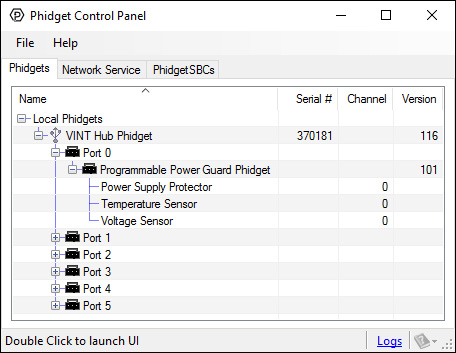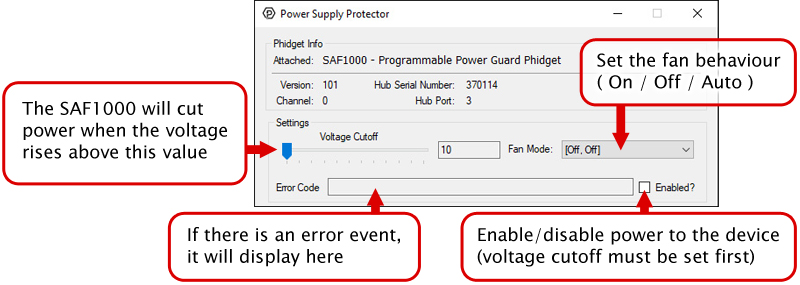SAF1000 User Guide: Difference between revisions
No edit summary |
No edit summary |
||
| Line 1: | Line 1: | ||
__NOINDEX__ | __NOINDEX__ | ||
__NOTOC__ | |||
<metadesc>Protect your circuit and power supply by detecting and preventing overvoltage/overtemperature events with the Programmable Power Guard Phidget.</metadesc> | <metadesc>Protect your circuit and power supply by detecting and preventing overvoltage/overtemperature events with the Programmable Power Guard Phidget.</metadesc> | ||
[[Category:UserGuide]] | [[Category:UserGuide]] | ||
== | ==Part 1: Setup== | ||
{{UGIntro|SAF1000}} | {{UGIntro|SAF1000}} | ||
* [{{SERVER}}/products.php?product_id=SAF1000 SAF1000 Programmable Power Guard Phidget] | * [{{SERVER}}/products.php?product_id=SAF1000 SAF1000 Programmable Power Guard Phidget] | ||
| Line 21: | Line 22: | ||
<br clear="all"> | <br clear="all"> | ||
==Using the | {{UGcontrolpanel|SAF1000}} | ||
== Part 2: Using Your Phidget == | |||
===About=== | |||
The Power Guard Phidget is designed to protect your hardware by detecting and preventing overvoltage and over-temperature situations. If the voltage or temperature exceeds the thresholds chosen in your program, it will automatically cut power. You can re-enable power via software when you’ve determined that conditions are safe to do so. | |||
===Explore Your Phidget Channels Using The Control Panel=== | |||
{{ | You can use your Control Panel to explore your Phidget's channels. | ||
'''1.''' Open your Control Panel, and you will find the following channels: | |||
[[Image:SAF1000_Panel.jpg|link=|center]] | |||
'''2.''' Double click on a channel to open an example program. Each channel belongs to a different channel class: | |||
{{UGC-Start}} | |||
{{UGC-Entry|Power Supply Protector:| Configures the voltage limit and fan settings | |||
| | |||
In your Control Panel, double click on "Power Supply Protector": | |||
[[Image:SAF1000-PowerGuard.jpg|center|link=]]}} | |||
{{UGC-Entry|Temperature Sensor:| Measures the ambient temperature| | |||
In your Control Panel, double click on "Temperature Sensor": | |||
[[Image:SAF1000-TemperatureSensor.jpg|center|link=]]}} | |||
{{UGC-Entry|Voltage Sensor:| Monitors the power supply voltage | |||
| | |||
In your Control Panel, double click on "Voltage Sensor": | |||
[[Image:SAF1000-VoltageInput.jpg|center|link=]]}} | |||
{{UGC-End}} | |||
{{UG-Part3}} | |||
== Part 4: Advanced Topics and Troubleshooting == | |||
{{UGC-Start}} | |||
{{UGC-Addressing}} | |||
{{UGC-Entry|Failsafe Feature|| | |||
Starting from firmware version '''110''', using Phidget22 library versions '''1.0.0.20190107''' and later, this device supports the use of a '''failsafe''' feature to put your device in a safe state should your program hang or crash. | |||
With this feature, the PowerGuard channel on this device has a settable '''failsafe timer'''. | |||
If the failsafe is not enabled, the device will behave as it did before the addition of this feature, maintaining the last state it received until it is explicitly told to stop. | |||
'''Enabling''' the failsafe feature for a channel starts a recurring failsafe timer. Once the failsafe timer is enabled, it must be '''reset''' within the specified time or the channel will enter a '''failsafe state'''. Resetting the failsafe timer will reload the timer with the specified failsafe time, starting when the message to reset the timer is received by the Phidget. | |||
'''''For example:''''' if the failsafe is enabled with a failsafe time of 1000ms, you will have 1000ms to reset the failsafe timer. Every time the failsafe timer is reset, you will have 1000ms from that time to reset the failsafe again. | |||
[[File:FailsafeDiagram.png|850px|link=|center|650px|border|Diagram of the failsafe behaviour when set to 1000ms]] | |||
If the failsafe timer is not reset before it runs out, the channel will enter a '''failsafe state'''. For PowerGuard channels, this will disable the power output. Once the channel enters the failsafe state, it will reject any further input until the channel is reopened. | |||
To prevent the channel from falsely entering the failsafe state, we recommend resetting the failsafe timer as frequently as is practical for your applicaiton. A good rule of thumb is to not let more than a third of the failsafe time pass before resetting the timer. | |||
Once the failsafe has been enabled, it cannot be disabled by any means other than closing and reopening the channel. | |||
When you use a failsafe in your program, we strongly recommend setting up an '''error event''' handler to catch the '''Failsafe Error Event''', to allow your program to catch the failsafe event. | |||
{{ | If you want your program to try to automatically recover from a failsafe state, you can close and re-open the channel from the error event handler after determining a failsafe condition caused the event. | ||
}} | |||
{{UGC-End}} | |||
Revision as of 21:34, 4 August 2020
Part 1: Setup
Welcome to the SAF1000 user guide! In order to get started, make sure you have the following hardware on hand:
- SAF1000 Programmable Power Guard Phidget
- VINT Hub
- Power supply
- Phidget cable
- USB cable and computer
Next, you will need to connect the pieces:

- Connect the SAF1000 to your VINT Hub using the Phidget cable.
- Connect the VINT Hub to your computer using the USB cable.
- Connect the positive power terminal of the device you're powering to the "OUT" terminal on the SAF1000.
- Connect the ground terminal of the device you're powering to the ground terminal on the SAF1000.
- Connect the positive and negative wires of your power supply to the "Vin" and "GND" terminals of the SAF1000, respectively.
- Plug in your power supply.
Phidget Control Panel
In order to demonstrate the functionality of the SAF1000, the Phidget Control Panel running on a Windows machine will be used.
The Phidget Control Panel is available for use on both macOS and Windows machines.
Windows
To open the Phidget Control Panel on Windows, find the ![]() icon in the taskbar. If it is not there, open up the start menu and search for Phidget Control Panel
icon in the taskbar. If it is not there, open up the start menu and search for Phidget Control Panel
macOS
To open the Phidget Control Panel on macOS, open Finder and navigate to the Phidget Control Panel in the Applications list. Double click on the ![]() icon to bring up the Phidget Control Panel.
icon to bring up the Phidget Control Panel.
For more information, take a look at the getting started guide for your operating system:
Linux users can follow the getting started with Linux guide and continue reading here for more information about the SAF1000.
First Look
After plugging the SAF1000 into your computer and opening the Phidget Control Panel, you will see something like this:

The Phidget Control Panel will list all connected Phidgets and associated objects, as well as the following information:
- Serial number: allows you to differentiate between similar Phidgets.
- Channel: allows you to differentiate between similar objects on a Phidget.
- Version number: corresponds to the firmware version your Phidget is running. If your Phidget is listed in red, your firmware is out of date. Update the firmware by double-clicking the entry.
The Phidget Control Panel can also be used to test your device. Double-clicking on an object will open an example.
Part 2: Using Your Phidget
About
The Power Guard Phidget is designed to protect your hardware by detecting and preventing overvoltage and over-temperature situations. If the voltage or temperature exceeds the thresholds chosen in your program, it will automatically cut power. You can re-enable power via software when you’ve determined that conditions are safe to do so.
Explore Your Phidget Channels Using The Control Panel
You can use your Control Panel to explore your Phidget's channels.
1. Open your Control Panel, and you will find the following channels:

2. Double click on a channel to open an example program. Each channel belongs to a different channel class:
In your Control Panel, double click on "Power Supply Protector":

In your Control Panel, double click on "Temperature Sensor":

In your Control Panel, double click on "Voltage Sensor":

Part 3: Create your Program
1. Setting up your Programming Environment
Part 4: Advanced Topics and Troubleshooting
Before you open a Phidget channel in your program, you can set these properties to specify which channel to open. You can find this information through the Control Panel.
1. Open the Control Panel and double-click on the red map pin icon:

2. The Addressing Information window will open. Here you will find all the information you need to address your Phidget in your program.

See the Phidget22 API for your language to determine exact syntax for each property.
Starting from firmware version 110, using Phidget22 library versions 1.0.0.20190107 and later, this device supports the use of a failsafe feature to put your device in a safe state should your program hang or crash.
With this feature, the PowerGuard channel on this device has a settable failsafe timer.
If the failsafe is not enabled, the device will behave as it did before the addition of this feature, maintaining the last state it received until it is explicitly told to stop.
Enabling the failsafe feature for a channel starts a recurring failsafe timer. Once the failsafe timer is enabled, it must be reset within the specified time or the channel will enter a failsafe state. Resetting the failsafe timer will reload the timer with the specified failsafe time, starting when the message to reset the timer is received by the Phidget.
For example: if the failsafe is enabled with a failsafe time of 1000ms, you will have 1000ms to reset the failsafe timer. Every time the failsafe timer is reset, you will have 1000ms from that time to reset the failsafe again.

If the failsafe timer is not reset before it runs out, the channel will enter a failsafe state. For PowerGuard channels, this will disable the power output. Once the channel enters the failsafe state, it will reject any further input until the channel is reopened.
To prevent the channel from falsely entering the failsafe state, we recommend resetting the failsafe timer as frequently as is practical for your applicaiton. A good rule of thumb is to not let more than a third of the failsafe time pass before resetting the timer.
Once the failsafe has been enabled, it cannot be disabled by any means other than closing and reopening the channel.
When you use a failsafe in your program, we strongly recommend setting up an error event handler to catch the Failsafe Error Event, to allow your program to catch the failsafe event.
If you want your program to try to automatically recover from a failsafe state, you can close and re-open the channel from the error event handler after determining a failsafe condition caused the event.
